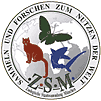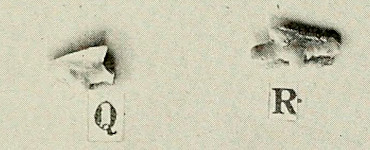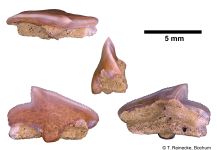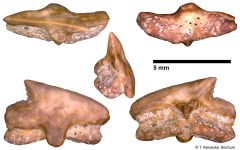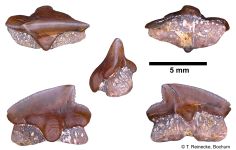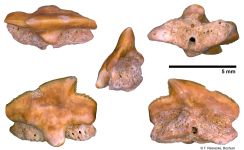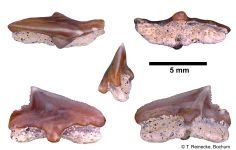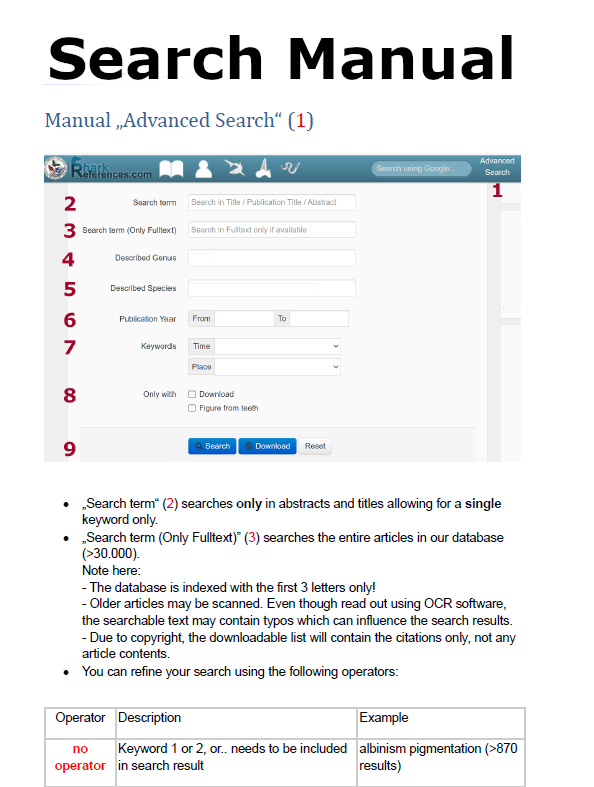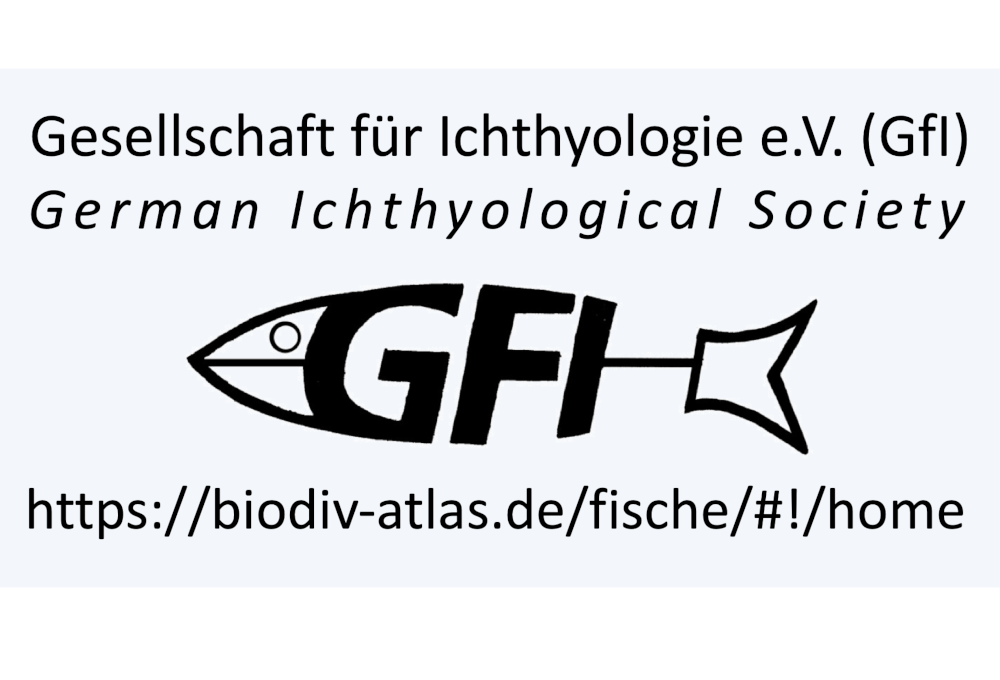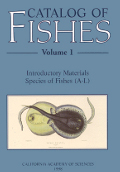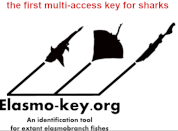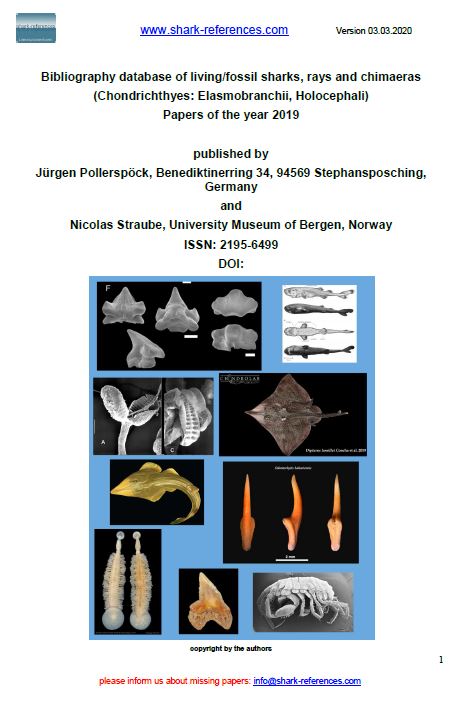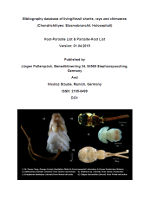Megasqualus occidentalis
(Agassiz, 1856)
Classification: Elasmobranchii Squaliformes Squalidae
Reference of the original description
Notice on the fossil fishes found in California by W.P. BLAKE. American Journal of Science and Arts, Series 2, 21, 272–275
Notice on the fossil fishes found in California by W.P. BLAKE. American Journal of Science and Arts, Series 2, 21, 272–275
Image of the original description
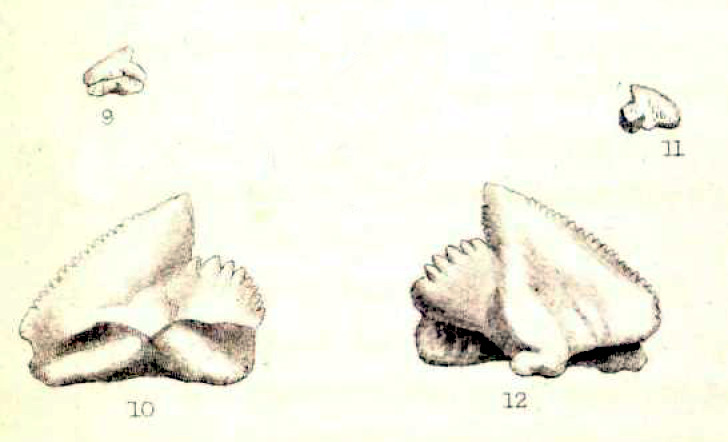
Megasqualus occidentalis (Agassiz, 1856), fig. 9-13 (in Agassiz, 1857)

Megasqualus occidentalis (Agassiz, 1856), fig. 9-13 (in Agassiz, 1857)
Synonyms / new combinations and misspellings
Dalatias occidentalis, Gyrace occidentalis, Megasqualus serriculus, Scymnorhinus occidentalis, Scymnus occidentalis, Squalus cf. serriculus, Squalus occidentalis, Squalus serriculus
Dalatias occidentalis, Gyrace occidentalis, Megasqualus serriculus, Scymnorhinus occidentalis, Scymnus occidentalis, Squalus cf. serriculus, Squalus occidentalis, Squalus serriculus
Types
Megasqualus occidentalis
Squalus serriculus
Holotype: SU(fossil): 937 (Accession Number: 58378.00); Paratype: SU(fossil): 939 (Accession Number: 58378.00);
Megasqualus occidentalis
Squalus serriculus
Holotype: SU(fossil): 937 (Accession Number: 58378.00); Paratype: SU(fossil): 939 (Accession Number: 58378.00);
Description:
Citation: Megasqualus occidentalis (Agassiz, 1856): In: Database of fossil elasmobranch teeth www.shark-references.com, World Wide Web electronic publication, Version 12/2025
Please send your images of "Megasqualus occidentalis" to info@shark-references.com
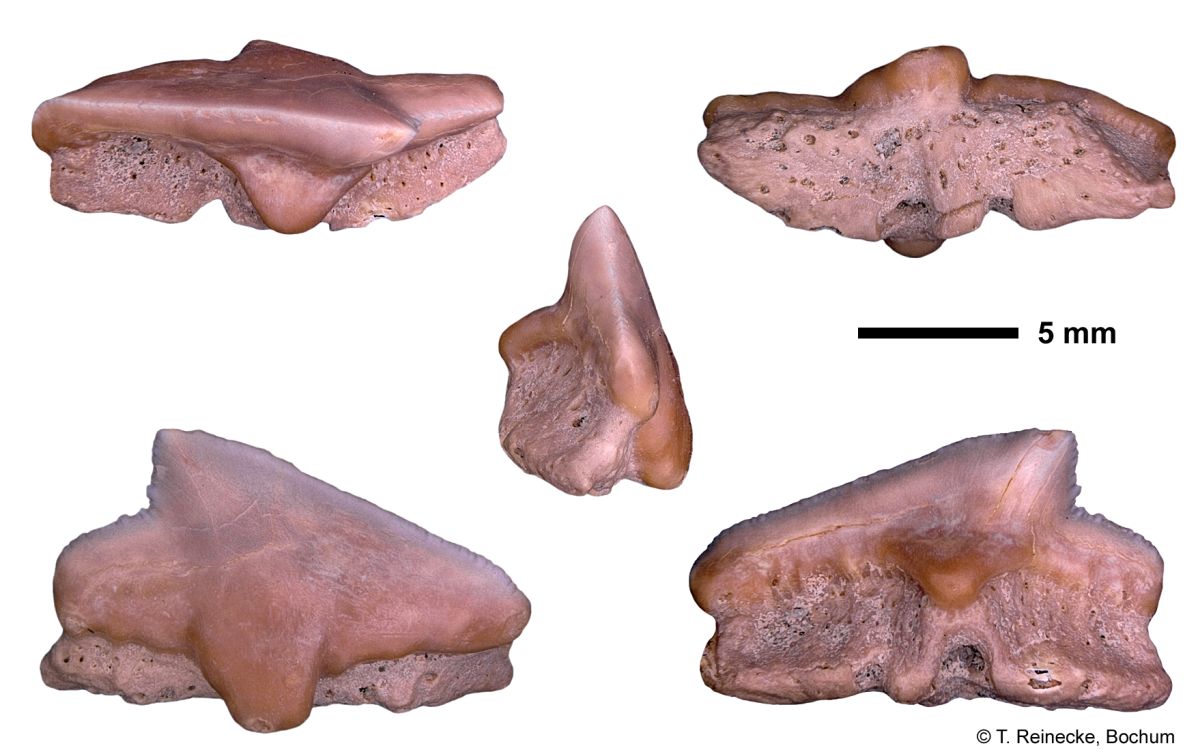
Megasqualus occidentalis (Agassiz, 1856); Sharktooth Hill Bone Bed, Round Mountain Silt, Temblor Formation, early Middle Miocene; Sharktooth Hill, Bakersfield, Kern County, California, USA; coll. J. Pollerspöck, Stephansposching, © T. Reinecke, Bochum.

Megasqualus occidentalis (Agassiz, 1856); Sharktooth Hill Bone Bed, Round Mountain Silt, Temblor Formation, early Middle Miocene; Sharktooth Hill, Bakersfield, Kern County, California, USA; coll. J. Pollerspöck, Stephansposching, © T. Reinecke, Bochum.
Description
Original description after Agassiz (1856) p. 272-273 [#26}, [2942]: Scymnus occidentalis, Agassiz, Pl. I, figs. 9—13.
The few species upon which Cuvier founded the genus Scymnus have been of late subdivided by Müller and Henle into two genera — Scymnus proper, and Laemargus — all of which are only known among the living. It is another of the highly interesting discoveries of Mr. Blake to have brought home two teeth from the Tertiaries of California belonging to this remarkable type. I would even not hesitate to consider them as indicating a distinct genus, were the number of specimens sufficient to warrant the inference that the teeth present in every position of mouth as great a difference from the true Scymnus and Laemargus as the two latter present when compared with one another. At all events, these teeth belong to the genus Scymnus, as established by Cuvier, and constitute a very distinct species, on account of the strong bend backwards of the main point of the tooth, and the distinct, and rather marked serration of the edges of the crown. Moreover, the inclination of the central point upon its basis gives these teeth a certain resemblance to those of Spinax and Centrophorus, and still more with Galeocerdo . The connexion of the teeth of the same row of the jaw with one another, was evidently the same as in the Scymnus and Laemargus , as is plainly shown, by the notch upon the inner surface of the root, and the articulating tubercle at the base of the enamel in both sides. The discovery of a fossil Scymnus in the Tertiaries of California is particularly interesting in a geographical point of view, since thus far no representative of the type has been found in the Pacific Ocean.
Original description after Agassiz (1856) p. 272-273 [#26}, [2942]: Scymnus occidentalis, Agassiz, Pl. I, figs. 9—13.
The few species upon which Cuvier founded the genus Scymnus have been of late subdivided by Müller and Henle into two genera — Scymnus proper, and Laemargus — all of which are only known among the living. It is another of the highly interesting discoveries of Mr. Blake to have brought home two teeth from the Tertiaries of California belonging to this remarkable type. I would even not hesitate to consider them as indicating a distinct genus, were the number of specimens sufficient to warrant the inference that the teeth present in every position of mouth as great a difference from the true Scymnus and Laemargus as the two latter present when compared with one another. At all events, these teeth belong to the genus Scymnus, as established by Cuvier, and constitute a very distinct species, on account of the strong bend backwards of the main point of the tooth, and the distinct, and rather marked serration of the edges of the crown. Moreover, the inclination of the central point upon its basis gives these teeth a certain resemblance to those of Spinax and Centrophorus, and still more with Galeocerdo . The connexion of the teeth of the same row of the jaw with one another, was evidently the same as in the Scymnus and Laemargus , as is plainly shown, by the notch upon the inner surface of the root, and the articulating tubercle at the base of the enamel in both sides. The discovery of a fossil Scymnus in the Tertiaries of California is particularly interesting in a geographical point of view, since thus far no representative of the type has been found in the Pacific Ocean.
Remarks
shark-references Species-ID=15051;
shark-references Species-ID=15051;
References
Paleozoic, Mesozoic and Cenozoic Chondrichthyes from the Japanese Islands. National Museum of Nature and Science Monographs, 56, 1–184

Bioluminescence and repeated deep-sea colonization shaped the diversification and body size evolution of squaliform sharks. Proceedings of the Royal Society B-Biological Sciences, 292(2042), Article 20242932
DOI: 10.1098/rspb.2024.2932

Faszination Haie – Die Welt der fossilen und der lebenden Haie. Der Steinkern, 58, 1–116

Elasmobranch fossils from the lower Miocene Akeyo Formation, Mizunami Group at the construction site of Mizunami-Kita Junior High School in Mizunami City, Gifu, Japan. [Japanese with English abstract] Bulletin of the Mizunami Fossil Museum, 44, Special Volume(2018), 39–42

4 - Enameloid Microstructure in Rays In Evolution of Dental Tissues and Paleobiology in Selachians, ISTE Press Ltd. Published by Elsevier Ltd.: 47-59
DOI: 10.1016/B978-1-78548-139-0.50004-3

Fossil record and origin of squaliform sharks (Chondrichthyes, Neoselachii). In Gallucci, V.F. & McFarlane, G.A. & Bargmann, G.G. (Eds). Biology and management of dogfish sharks. American Fisheries Society. Bethesda, Maryland: 19–38

Fossil record and origin of squaliform sharks (Chondrichthyes, Neoselachii). In Gallucci, V.F. & McFarlane, G.A. & Bargmann, G.G. (Eds). Biology and management of dogfish sharks. American Fisheries Society. Bethesda, Maryland: 19–38

Fossil Shark Teeth of the World. Lamna Books, 170 p

Haaien- en roggentanden uit Liessel (N.-B.) Fontys Hogescholen, Tilburg
Occurrence of a squaloid shark (Chondrichthyes: Squaliformes) with the pinniped Alloddesmus from the upper Miocene of Washington. Journal of Paleontology, 68(3), 680–684

Megasqualus serriculus Jordan and Hannibal (Squalidae: Squaliformes: Elasmobranchii) from the Middle Miocene Nanao Calcareous Sandstone, Nanao City, Noto Peninsula, Central Japan. Bulletin of the Mizunami Fossil Museum, 18, 33–45

Late Cenozoic elasmobranchs from the Hokuriku district, Central Japan. Science Reports of Kanazawa University, 34(1): 1–57, 1 fig., pl. 1–8

Late Cretaceous and Cenozoic Squalomorphii of the Northwest Pacific Ocean. PhD, Univ. of California Berkeley, 553 p., 71 fig.
Fossil sharks and rays of the Pacific slope of North America. Bulletin of the Southern California Academy of Sciences, 22, 27–63, pl. 1–10
Fossil sharks and rays of the Pacific slope of North America. Bulletin of the Southern California Academy of Sciences, 22, 27–63, pl. 1–10
Fossil fishes of southern california, Part III. Fossil fishes of the Pliocene Formations. Stanford University Publications, University Series: 61–64
Fossil fishes of southern california, Part II. Fossil Fishes of the Miocene (Monterey) Formations. Stanford University Publications, University Series: 13–60

Supplementary notes on fossil sharks. Bulletin Department of Geology, University of California, 7, 243–256

The fossil fishes of California with supplementary notes on other species of extinct fishes. Bulletin Department of Geology, University of California, 5(7), 95–145

Bibliography and catalogue of the fossil Vertebrata of North America. Bulletin of the United States Geological and Geographical Survey of the Territories, 179, 1–868
Notice of the fossil fishes. In Reports of explorations and surveys, to ascertain the most practicable and economical route for a railroad from the Mississippi River to the Pacific Ocean, Volumes I to X, 5: 313–316
Paleozoic, Mesozoic and Cenozoic Chondrichthyes from the Japanese Islands. National Museum of Nature and Science Monographs, 56, 1–184

Bioluminescence and repeated deep-sea colonization shaped the diversification and body size evolution of squaliform sharks. Proceedings of the Royal Society B-Biological Sciences, 292(2042), Article 20242932
DOI: 10.1098/rspb.2024.2932

Faszination Haie – Die Welt der fossilen und der lebenden Haie. Der Steinkern, 58, 1–116

Elasmobranch fossils from the lower Miocene Akeyo Formation, Mizunami Group at the construction site of Mizunami-Kita Junior High School in Mizunami City, Gifu, Japan. [Japanese with English abstract] Bulletin of the Mizunami Fossil Museum, 44, Special Volume(2018), 39–42

4 - Enameloid Microstructure in Rays In Evolution of Dental Tissues and Paleobiology in Selachians, ISTE Press Ltd. Published by Elsevier Ltd.: 47-59
DOI: 10.1016/B978-1-78548-139-0.50004-3

Fossil record and origin of squaliform sharks (Chondrichthyes, Neoselachii). In Gallucci, V.F. & McFarlane, G.A. & Bargmann, G.G. (Eds). Biology and management of dogfish sharks. American Fisheries Society. Bethesda, Maryland: 19–38

Fossil record and origin of squaliform sharks (Chondrichthyes, Neoselachii). In Gallucci, V.F. & McFarlane, G.A. & Bargmann, G.G. (Eds). Biology and management of dogfish sharks. American Fisheries Society. Bethesda, Maryland: 19–38

Fossil Shark Teeth of the World. Lamna Books, 170 p

Haaien- en roggentanden uit Liessel (N.-B.) Fontys Hogescholen, Tilburg
Occurrence of a squaloid shark (Chondrichthyes: Squaliformes) with the pinniped Alloddesmus from the upper Miocene of Washington. Journal of Paleontology, 68(3), 680–684

Megasqualus serriculus Jordan and Hannibal (Squalidae: Squaliformes: Elasmobranchii) from the Middle Miocene Nanao Calcareous Sandstone, Nanao City, Noto Peninsula, Central Japan. Bulletin of the Mizunami Fossil Museum, 18, 33–45

Late Cenozoic elasmobranchs from the Hokuriku district, Central Japan. Science Reports of Kanazawa University, 34(1): 1–57, 1 fig., pl. 1–8

Late Cretaceous and Cenozoic Squalomorphii of the Northwest Pacific Ocean. PhD, Univ. of California Berkeley, 553 p., 71 fig.
Fossil sharks and rays of the Pacific slope of North America. Bulletin of the Southern California Academy of Sciences, 22, 27–63, pl. 1–10
Fossil sharks and rays of the Pacific slope of North America. Bulletin of the Southern California Academy of Sciences, 22, 27–63, pl. 1–10
Fossil fishes of southern california, Part III. Fossil fishes of the Pliocene Formations. Stanford University Publications, University Series: 61–64
Fossil fishes of southern california, Part II. Fossil Fishes of the Miocene (Monterey) Formations. Stanford University Publications, University Series: 13–60

Supplementary notes on fossil sharks. Bulletin Department of Geology, University of California, 7, 243–256

The fossil fishes of California with supplementary notes on other species of extinct fishes. Bulletin Department of Geology, University of California, 5(7), 95–145

Bibliography and catalogue of the fossil Vertebrata of North America. Bulletin of the United States Geological and Geographical Survey of the Territories, 179, 1–868
Notice of the fossil fishes. In Reports of explorations and surveys, to ascertain the most practicable and economical route for a railroad from the Mississippi River to the Pacific Ocean, Volumes I to X, 5: 313–316
